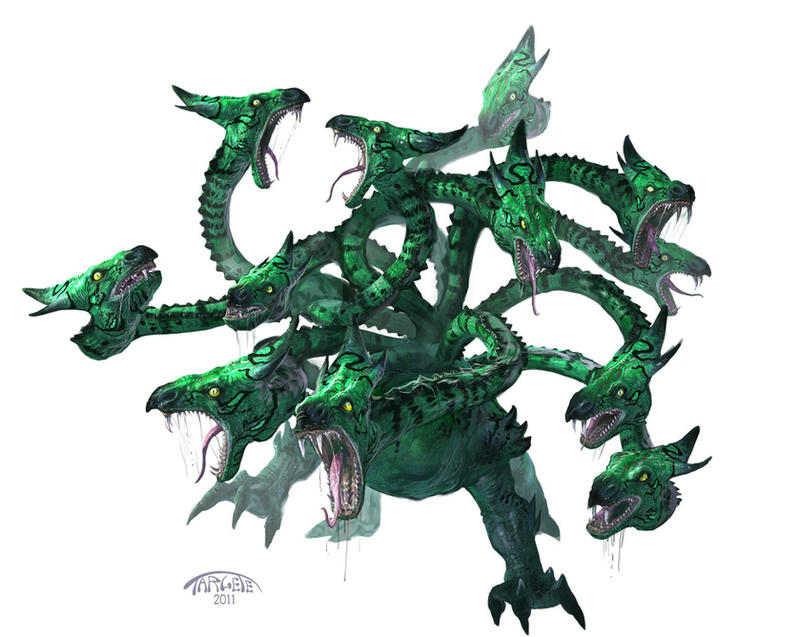| Level | 6 |
| Alignment | |
| Images of hydras | |
Source: Bestiary, pg(s). 210 | |
Hydra
| Hydra | |
|---|---|
 | |
| (Creature) | |
Hydras1 are many-headed, swamp-dwelling reptiles best known for their ability to sprout new heads when decapitated.2
Ecology
The typical hydra resembles a large, stout-bodied reptile with multiple writhing, serpentine necks culminating in snakelike, crocodilian, or draconic heads. If one of these heads is cut off, two more grow from the stump unless it is seared with fire or acid.2
This unique form of regeneration is linked to the hydras' method of reproduction: the new heads generate as embryonic sprouts in submuscular fossae within the creatures' necks, waiting to transform into new heads when the ones they reside in are severed. If this does not happen, the larval heads grow inside the neck until they are either disgorged in leathery cysts, which the hydra then broods like eggs until they hatch into swarms of tadpole-like larvae, or physically tear their way free of their parent's neck, at which point the largest larva attaches itself to the parent hydra as a new head and the rest move away as a swarm. The larvae remain together until they mature into young, multi-headed hydras, after which they leave the swarm to set off on their own.2
Habitat and society
Hydras live in warm or temperate swamps, although some have been reported as living in coastal reefs. More specialized hydra varieties, such as pyrohydras and cryohydras, are known to inhabit more exotic environments.2
Hydras are carnivores, and need to regularly eat large amounts of food in order to sustain their regenerative abilities. They prefer larger prey, which they often devour whole and digest over long periods of time; a hydra can consume half its weight in food in a single sitting, after which it will be able to go without eating for up to a week. Humanoids are particularly desirable prey, especially sturdier ones such as dwarves, but when prey is scarce, hydras can subsist on carrion or small swamp-dwelling creatures such as snails, worms, or frogs gleaned from swamp mud. Particularly hungry hydras can feed on vegetation, although given a choice they always prefer meat. Desperate times can see hydras engaging in cannibalism; hydras driven to this point will fight one another to the death, with the victor of these clashes then consuming every scrap of the loser's flesh.2
While hydras do not possess the intellect to value treasure for its own sake, they do recognize that other creatures often go to great peril to seek it out. As such, hydras often gather treasure that they find in their territories or on their prey and display it in their lairs to lure future prey to them. As hydras lack an awareness of value beyond knowing that sparkling or shiny things are sought after by some of its prey, they will typically ignore drab items but display potentially valueless but shiny rubble.3
Hydras often live in symbiosis with small vermin, which feed on algae growing over their host's scales and on parasites infecting it. These symbionts are the only creatures that hydras will not try to devour.2
Adult hydras are solitary creatures; as asexual beings, they tend to see others of their kind only as competitors. However, hydras may tolerate the presence of conspecifics when resources are enough to support them, due to the aid that these can give in taking down large prey or fending off potential predators.2
In Golarion
Hydras are widespread creatures, and can be found in swamps, bayous, and other wetlands throughout Casmaron, Avistan, and Garund.2
Hydras are sometimes captured by wizards, witches, or alchemists to serve as test subjects in experiments concerned with the creatures' regenerative abilities. Some eccentric scholars claim the hydras' regeneration may provide the secret to immortality, but these claims are rarely taken seriously.4
Hydras can be found in the delta of the River Sphinx in Osirion, coastal forests throughout Avistan, the Mushfens of Varisia, around Lake Encarthan, and in the wetlands of the River Kingdoms; one particular hydra found in this area, known as Ladonica, is thought to have been enchanted by magic from the First World after stumbling on a portal to the world of the fey within the Wilewood. Recently, hydras have also migrated to the Sodden Lands, easily taking to the new habitat formed by the flooding of Lirgen and Yamasa and making lairs in the drowned ruins of the two nations.5
Hydras plague caravans in Thuvia, though druids of the Thuvian city of Duwwor have found ways to domesticate or befriend more than a dozen of them.5
Variants
Numerous subspecies and variants of hydras are known to exist, including pyrohydras and cryohydras; three-headed schism hydras, which are capable of splitting into two copies of themselves; grave hydras closely linked to necromancy; and the powerful, rare, and twelve-headed miasma hydras.26
References
- ↑ Plural form is either hydras or hydrae.
- ↑ 2.0 2.1 2.2 2.3 2.4 2.5 2.6 2.7 2.8 . “Hydra” in Mythical Monsters Revisited, 28–33. Paizo Inc., 2012
- ↑ . “Hydra” in Mythical Monsters Revisited, 30–31. Paizo Inc., 2012
- ↑ . “Hydra” in Mythical Monsters Revisited, 30. Paizo Inc., 2012
- ↑ 5.0 5.1 . “Hydra” in Mythical Monsters Revisited, 31. Paizo Inc., 2012
- ↑ . Bestiary. Paizo Inc., 2009